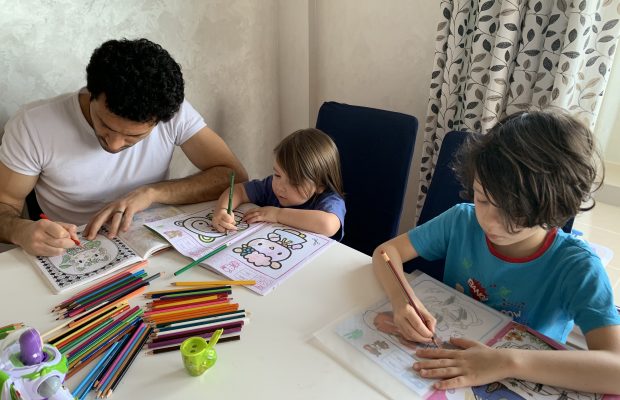Greetings Everyday Spy,
Right now, there are 10,000 spies living undercover in Washington, D.C.
Some are from CIA, like me. But most are not.
They are intelligence operatives from around the world who have gone undercover as diplomats, businessmen, journalists, and a variety of other creative and innovative identities.
They are the best spies their country has in service, and they were all excited to deploy to our Nation’s capital – to the heart of our democracy.
But then came the Coronavirus.
Spies are specialists, trained in everything from mental judo (aka: ‘Operational Thinking’) to overseas personal security (aka: ‘tactical weapons and driving’).
But when a national catastrophe puts the country where we are living on lock-down, our offensive training takes a back seat. Instead, rely on training that helps us maintain our skills.
- Creative Thinking
- Focus/Memory
- Physical Strength
I am no longer living in the capital of the United States. Instead, I live in a foreign capital – the city of Abu Dhabi.
And like so many other cities in the world, my current home is shutting down non-essential business, enforcing quarantines, and closing schools. Which means my work life – like yours – has had to adopt a new daily routine.
I have two small children that I need to protect and educate during the current COVID19 crisis.
I see all the same parenting headlines and social media commentary that you see.
I know parents struggling to transition kids to online school. I know parents arguing details about homeschool vs. virtual school.
And yes, I also want to smack couples without kids who complain about being bored right now.
Most of the chatter flying around on Twitter, Facebook, and the 24 hour news cycle is not helping moms and dads engage their children in meaningful learning.
But CIA trained me to prepare for long-term isolation.
They gave me tools to maintain and even improve my mental and cognitive abilities during times of captivity, quarantine, or hiding. And while not all of those skills are appropriate for children, many of them are.
If they can help you right now, then I want you to have them.
Here are 5 CIA learning activities I am using to educate my children while Coronavirus has us stuck indoors:
1. Student-Led YouTube Sessions
YouTube can be the mother of all time-sucks or a fountain of education, depending on how you use it.
There has long been an educational strategy called ‘student-led’ (or ‘peer-led’) learning. This practice involves letting the student decide what they want to learn and when they want to learn it. Whatever that topic may be, the adult’s role is only to guide the learning experience. They ask questions and encourage curiosity, but they do not ‘teach’.
Students get to learn through discovery and experience, the same way we all learn the lessons we remember longest.
While this strategy totally contradicts rigid public school curriculum and standardized testing models, it is the backbone of the American University system. After primary school and throughout our professional lives, we choose what to learn, when to learn it, and how deep we want our learning to go.
YouTube is an outstanding tool for experimenting with student-led learning.
It has a huge variety of content, links related content together, and presents information in a visually engaging way.
Yes, parents will need to police their student against click-bait ads and distracting content. But with a few parental controls and some quality parent/kid time on the couch, it can be inspiring to see what your child chooses to study when they aren’t forced to learn.
My son Sina spends his student-led YouTube time studying animals.
Sometimes they are sea animals (mimic octopus, pistol shrimp, killer whales), sometimes they are insects (Kung-fu mantis, Japanese hornets, Jumping spiders) and sometimes they are mythical/historic creatures (Megalodons, Dragons, Gnomes). But regardless of the topic, his curiosity gets to take over and he loves the learning process.
CIA taught me that you have to love learning to make what you learn permanent.
Otherwise, the information you study isn’t retained. And that is the same as never learning it at all.
2. Physical Horseplay
Hey mom, I can see you cringing as you read the heading.
But that doesn’t make it any less true. Children need physical activity. Not structured time like us adults, but unstructured, dynamic activity time.
As adults, our joints and muscles have been developed for repetitive motion.
We have built up decades of muscle memory, strength and resilience for moving in certain ways: walking, running, cycling, etc. And as we age, we continue to prioritize physical activity in the ways where we are most comfortable. It’s why old couples too fragile to climb stairs can still go for long walks together – their walking muscles are strong and well-trained, but their climbing muscles are not.
Indoor physical horseplay can give kids dynamic, non-repetitive, weight-bearing exercise that is important for joint development, bone density, and deep sleep.
It’s what they would be doing outside if they could, but they can’t. And you can give them not only a safe space to play, but also a safe playmate and personal trainer.
Physical activity is critical to a child’s learning. It gives them a place to experiment and explore physics, problem solving, and individual focus. It allows them to burn excess energy that would distract them during other learning activities. And most importantly, it prepares their body for restful sleep, where the day’s information gets indexed by the brain for future recall.
Every time my family and I move to a new country, we convert the largest room (usually the living room) into a safe indoor play space.
It still serves as the living room, but we pad the floors with foam tiles or thick rugs, place furniture around the walls instead of in the middle of the room, and hang the TV on a wall mount.
Our children (7 years old and 2 years old) have predictable energy spikes about 15 minutes after they eat a meal. So I prepare myself to get physical with them around their eating schedule.
With Coronavirus, we do the playtime routine 3 times a day indoors since we can’t take them out to a playground.
I wrestle with them, tickle them, and let them jump from the sofa into an imaginary pool on the floor.
I chase them around the house, pin them down until they escape, let them ride on my back or climb up my front like mountaineers. We play tickle monsters, power rangers, scuba divers, Bakugan brawl, ninjas, and of course spy kids.
The indoor play area has been a boon for us living through desert heat, tropical rains, hurricane season and now a global pandemic.
On deployment, CIA officers workout together on a daily basis: sparring, wrestling, racing, rucking, and more.
A body that is left to repetitive motion is prone to injury. And injuries heal slower as we age.
3. Immersive Training
CIA field training is fully immersive – that is what makes it so effective.
When we go to the Farm, we are immersed in a comprehensive training program that cuts us off from the real world. We don’t visit friends or family, we disappear from social events, it is our first real experience going black (aka: going operational).
Immersive environments are a powerful learning tool because they bring you into a self-contained world.
A world where information and events are selective and intentional, unlike the real world where events can be disjointed and random.
If you want to train someone to master deception, risk taking, and escape, you need to start them in a world with very few variables. Then, over time, you can introduce more complexity that advances their training and prepares them to operate in real-time.
Children perform exceptionally well in immersive situations, from learning foreign languages to learning science.
That is because they think without the social barriers that limit adults. To a child, no idea is ‘stupid’, they don’t care ‘what everyone else thinks’, and they will try just about anything that might be fun.
My children tell me to my face they don’t want to learn Arabic, but they use Arabic when they need to. They tell me they don’t want to learn Spanish, but they read it in books and translate it from TV shows. In both cases, it’s because they can’t help but learn from the world around them.
What a child lives, they learn.
While you will usually hear me talk about the benefits of role playing, imagination, and turn-based gaming right about now, I’m gonna skip that. Instead, I’m gonna spend a few minutes recommending Netflix and their interactive children’s content.
Netflix has been rolling out some outstanding interactive content that also offers immersive educational benefits.
My kids love traveling with Carmen Sandiego in the ‘To Steal or Not to Steal’ choose-your-own-adventure show. They like it because they can experiment with different choices and see how their choices play out. I like it because not every choice brings them success – there are genuine ‘Mission Failed’ scenarios that test my kid’s reasoning and judgement.
My son was in love with Captain Underpants books long before Netflix created the ‘Epic Choice-O-Rama’ and my wife and I enjoy winding our way with Puss in Boots as he is ‘Trapped in an Epic Tale.’
Immersion hones focus, limits distractions, and drives home the relationship between cause and effect.
The same tool that prepares covert operatives for deep cover ops can help your children learn in a world far beyond your living room.
4. Family Art
When my mom was in nursing school, she had a book called ‘The Gray’s Anatomy Coloring Book’.
I’ve never been one to understand art. I’ve learned some of the catch words and been trained in how to talk about it. But I still don’t ‘feel’ much of anything when I look at art.
But for my mom – raising 3 kids, working a day job, and going to night school for nursing – her coloring book brought her real value.
The book helped her memorize organs, bones, and complex organic systems. It gave her a learning tool to help her in a tactile way to memorize English and Latin terms.
And the act of coloring, stroke by stroke, reduced her stress levels and helped her retain what she had learned in school.
I still don’t get excited about art museums or coffee table books with famous paintings. But I live by the power of art to aid learning.
I sit with my children almost daily to color with them. Sometimes they color from a book, other times they draw their own scene and color it in. My coloring book of choice right now is a Japanese themed concentration book, full of detailed lanterns, Asian myths, and ornate patterns.
Coloring helps my children practice fine motor skills, consistency and focus.
The emphasis on right brain creativity frees the left brain to process rational thoughts and experiences from the day. It also gives me and momma a chance to talk to both kids about their thoughts and feelings in a non-threatening, calm environment.
They are still kids, so we can’t keep them coloring for more than 25-45 minutes. But in that time they are getting exponentially more benefit then they realize: boosting memory, increasing emotional awareness, and reducing anxiety.
Every CIA field officer carries some kind of notepad and at least one colored pen.
Because we understand the freedom that comes from putting ink on paper; creating something where there was nothing. We manage fear and stress using sketches and drawings, and then cross international borders where customs officials just think we are everyday doodlers.
5. Auditory Options
It has been encouraging to see major online retailers offering free access to their content during this challenging time.
Newspapers, learning forums, web-based educational tools and more are working to give students and parents every possible opportunity to advance their child’s education.
But the primary options you see online are biased toward children who learn visually.
In fact, there are three ways children (and all people) learn: visual, auditory, and kinesthetic. To maximize your child’s opportunity to learn, it is important to give them all three options.
In this article, we talked about visual learning options, like student-led YouTube and Netflix’s interactive content. We talked about kinesthetic learning options, like my mom’s anatomy coloring book and making space for horseplay in the house.
Now I want to help you explore auditory options to boost your child’s learning while stuck indoors.
First, I am beyond grateful to Audible for standing up a dedicated website with free audio books for all children. We’ve been able to jump into all kinds of fun and interesting books for the kids. And because the books are audio only, we reduce the kid’s screen time, encourage their imagination/visualization, and get to bond as a family.
Another great place to find audio books for kids is with an App called HOOPLA. We discovered hoopla when we started traveling full time. We wanted access to a library, but nobody would give our band of wandering CIA gypsies a library card. So a few clicks later, we got onto hoopla.
Audio books have given us endless hours of productive learning time with both our 7 year old son and our 2 year old daughter.
Unlike visual tools (books, movies, online sites), audio options are far less tiring for both the kids and us parents. There are no flashing lights, no intrusive ads, and no physical eye strain. Instead, everyone can listen in their own way.
In our family, I like to listen and color. The baby likes to listen and build with LEGOs. My son likes to huddle next to the audio book and imagine every word. And my wife likes to bounce between us giving kisses and browsing her phone for meaningful news updates (she never switches off…).
The Agency delivers training in all three modalities to maximize learning options for its operators.
And CIA officers discover and appreciate exactly how they learn best.
I hope my time with CIA can help you connect and encourage learning with your kids like I have with mine.
Godspeed, #EverydaySpy
Want more? Sign Up To Get Spy Skills Weekly
Author: Andrew Bustamante, Founder of www.EverydaySpy.com. Andrew is a former covert CIA Intelligence officer, decorated US Air Force Combat Veteran, and respected Fortune 500 senior advisor. Learn more from Andrew on his Podcast (The Everyday Espionage Podcast) and by following @EverydaySpy on your favorite social media platform.



